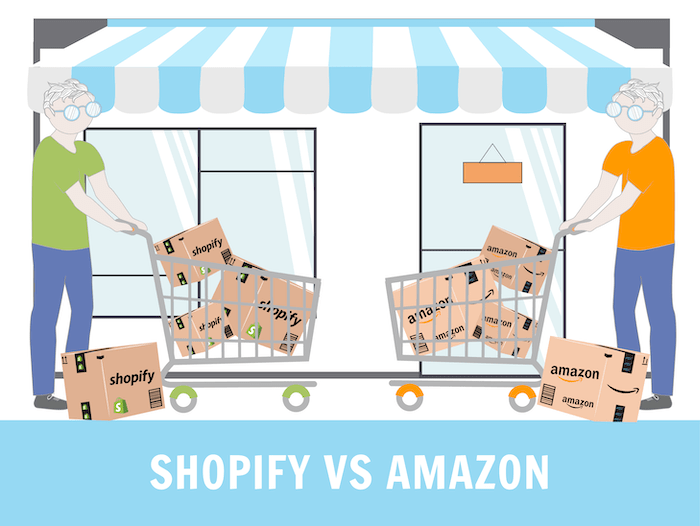Tooltester is supported by readers like yourself. We may earn an affiliate commission when you purchase through our links, which enables us to offer our research for free.
Where do you go if you’re looking to buy something online?
I’m thinking Amazon is a top pick due to the sheer range of products it has available. So would it make sense to sell on Amazon if you’re looking to run an ecommerce business? Not necessarily. Shopify is a popular ecommerce platform too and it didn’t gain this reputation for nothing.
It’s a solid choice for anyone looking to set up an ecommerce business, even if they’re new to this space. That said, Shopify and Amazon aren’t mutually exclusive platforms.
In other words, just because you choose to use one of them doesn’t mean you can’t use the other. In fact, you can link your own Shopify online business to Amazon for selling your stuff on Amazon too!
Shopify vs Amazon: The opinion of ToolTester
First of all, the two platforms are very different. But Shopify wins in most categories of comparison due to its ease of use, greater potential for customization, a wider range of payment options and simpler pricing.
On the other hand, Amazon is more complex to set up and will require sellers to be able to troubleshoot issues on their own instead of relying on support.
But I’m getting ahead of myself.
If you’re not sure whether to choose Shopify or Amazon for your ecommerce website, read on as I score both platforms according to not one but 10 criteria.
Our opinion about Shopify…
At the end of the guide, you should have a pretty good idea of their pros and cons, and whether Shopify or Amazon might be right for you.
Let’s dive in!
The pros of Shopify: Why you should use it?
Ease of use of Shopify
Setup is easy and the platform is simple to use. Hosting is also taken care of for you, so you can spend less time juggling the technical backend work and more time running your own online business.
Designs and flexibility
There is a wide range of online website themes available, so you can customize your own online business look to exactly how you want it to be.
Ownership of the sales channel
You have full ownership over your online business and can run multiple sales channels to bring in more orders.
Shopify’s pricing
Shopify’s pricing is easy to understand. Just pay Shopify a flat monthly fee and a low transaction fee per sale, and the rest is yours to keep (after settling shipping and other necessary fees).
Payment made easy
customers who are registered for Shop Pay won’t need to type in their details – on any Shopify online store. Now that some serious competition for the convenience you previously only experienced on Amazon.
The cons of Shopify ecommerce: Why you should not use it?
Multilingual capabilities of Shopify
Shopify doesn’t offer native multilingual options. For that, you’ll need to install a separate translation app.
Fulfillment
You’ll need to settle order fulfillment by yourself—Shopify won’t handle this for you. FBA (Amazon) is still more established and more widely available!
Marketing
You’ll be responsible for marketing and driving traffic to your own online site on your own, because you aren’t tapping on a platform’s existing customer base to get orders.
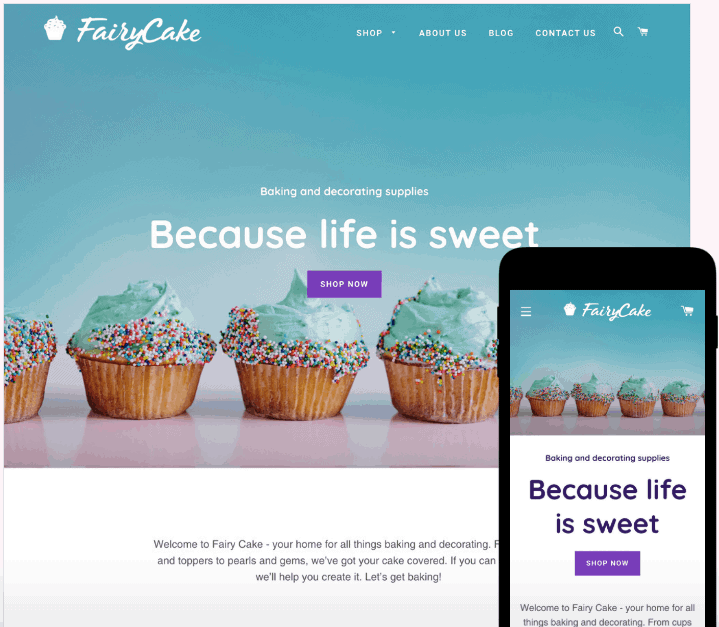
The pros of Amazon online stores: Why you should use it?
Popularity of Amazon
Amazon dominates ecommerce in many countries, making it the possible “it” place to be if you want to enter the ecommerce space.
Marketing
Amazon offers a ready (and loyal, and large) base of customers, which may help you get significant sales with minimal marketing efforts.
International presence
Reach and sell to an international customer base effortlessly, due to Amazon’s wide global recognition.
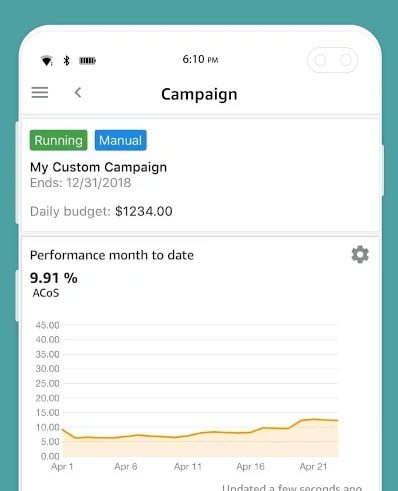
Fulfillment
With Fulfillment by Amazon (FBA), you can outsource your fulfillment to Amazon instead of having to manage it yourself.
The cons of Amazon online stores: Why you should not use it?
Customization of Amazon
There isn’t much customization you can do to help your product listings stand out, which can be an issue, especially since competition with other sellers will be extremely high.
Amazon’s pricing
Amazon charges a range of fees for different services and product categories. In comparison, Shopify’s offers a much simpler pricing structure.
More information on Amazon’s fees here: as you will see, the average is around 15%, which is significantly more than Shopify’s payment fees.
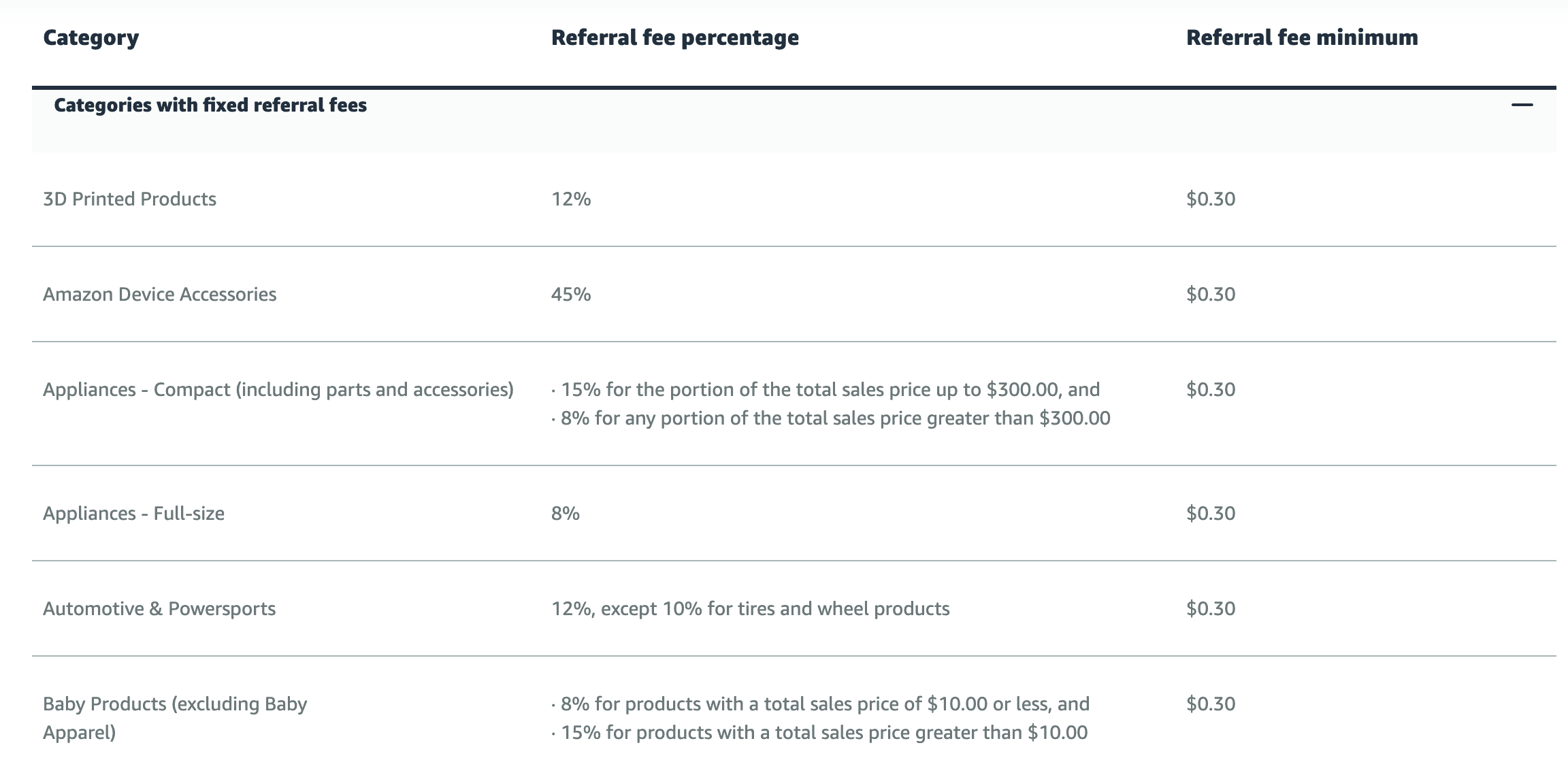
Support
Live support appears to generally be unsatisfactory and possibly even non-existent.
Replication
Amazon tends to copy successful products for adding to its own Amazon Basics product line, and your products are more likely to get noticed and copied in this way if they’re listed on Amazon as they have full insights into your sales figures.
Round 1: Popularity of Shopify ecommerce vs Amazon
According to Shopify’s 2020 annual report, the platform hosted close to 1.8 million merchants from around 175 countries.
Their shops averaged 386 million unique monthly visitors and almost 5.9 billion monthly browsing sessions. Shopify also processed an average of 121.1 million orders per month.
On the other hand, Amazon reports having over 1.9 million small and medium-sized businesses (not including large enterprises) on its platform in 2020, which contributed close to 60% of its retail sales. Third-party seller profits are also estimated to be around $25 billion.
Amazon popularity vs Shopify
Amazon’s clearly leading the popularity contest, for having more users on its platform even before we factor in its user base of large enterprises.
And if you need more persuading, let’s also check out Shopify and Amazon’s search popularity on Google over the last five years…
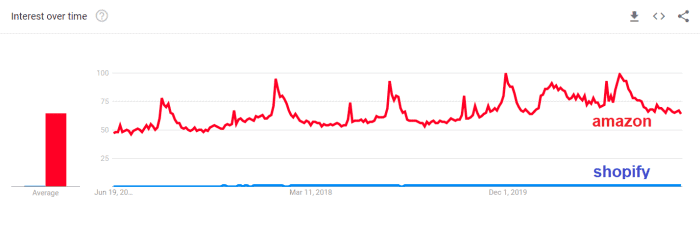
As you can see, search interest in Amazon way exceeds that of Shopify.
If I had to guess, I would say that “amazon” searchers are mostly people looking to buy products on Amazon, while “shopify” searchers are new/existing business owners thinking of starting an ecommerce store using Shopify, which would be a smaller crowd.
These different audiences would explain the huge discrepancy in search interest—which also suggests that if you want to target a larger existing customer base, Amazon is the way to go.
Winner: Amazon, hands down.
Round 2: Ease of Use of Shopify ecommerce vs Amazon
Having reviewed many ecommerce platforms, I can confidently say that Shopify is one of the easiest to use and set up by far.
For one, unlike with say WooCommerce, you don’t need to worry about hosting your online store, because Shopify takes care of that for you.
And once you create your Shopify account, you’ll be guided through the setup process. Your own online store can be up in just a few clicks!
Setting up an Amazon store vs Shopify ecommerce
In contrast, setting up an Amazon website involves more work and complexity.
For example, you’ll need to understand how product categories work (there are many restrictions on what you can sell in various categories).
You’ll also need to think about whether you want to fulfill your orders yourself, or have Amazon do so for you through the FBA scheme, which has its own set of rules.
Failure to comply with Amazon’s rules can lead to a ban, and Amazon isn’t afraid to drop the ban hammer. There are plenty of such horror stories online—you definitely don’t want to be the next one.
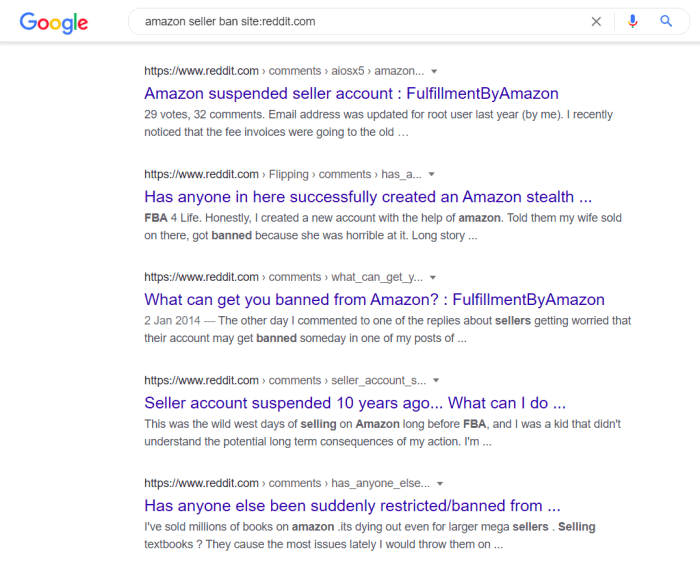
Winner: Shopify, because it makes setting up an ecommerce website such a breeze.
With Amazon, expect a steeper learning curve and more compliance requirements, which may be off-putting. If you are looking for an even easier option than Shopify, you can also check out Wix.
Round 3: Designs and flexibility of Shopify ecommerce vs Amazon
Shopify’s Theme online Store offers over 100 ecommerce store themes in a wide variety of layouts and category styles. Choose your favorite, then add it to your Shopify site to start using it right away.
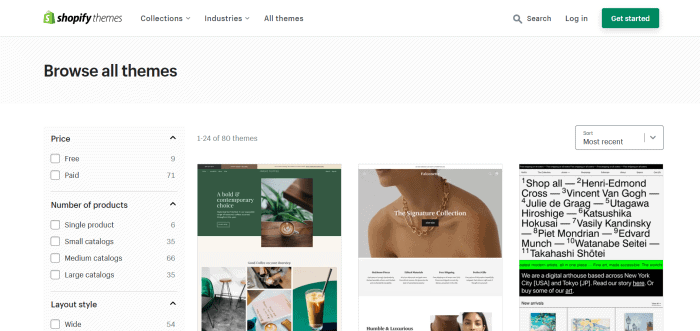
The catch is that not all these themes are free—the paid ones cost around $160 to $180.
If you’d prefer, you can get a Shopify theme from third-party marketplaces such as Themeforest (often at a lower cost), or have one custom-developed by a Shopify expert.
Customization on Amazon sites vs Shopify
On the other hand, if you’ve ever shopped on Amazon, you may be wondering: “Where’s the customization? I’m not seeing it.”
And you’d be right, because there is…not much to customize.
Amazon product listings pretty much all look like this:
That said, you can create a “Store” on Amazon, which will give you a customized storefront page for your own Amazon online business.
However, online stores aren’t available in all countries.
You’d also need to be enrolled in the Amazon Brand Registry (see Round 2 about Amazon having many different schemes and rules).
Winner: Shopify, with its wider range of customization options and greater design flexibility.
Round 4: Product presentation and features of Shopify vs Amazon
With greater design flexibility comes greater choice in product presentation. So following Shopify’s win in the design department, it naturally also wins the next comparison on product presentation and features.
There are many ways of presenting your product in your Shopify store, from displaying one product per page or listing all your products in a collage.

You can also customize the features of your product pages, be it including a gallery, image zoom or something else. Simply choose the appropriate Shopify business theme to get started.
As for Amazon, well, you don’t have much say in how your products will be presented.
They’ll be displayed in the same way as other products on the platform, using Amazon’s standard template.
This can help save some decision-making on how you want to showcase your products, but at the cost of not being able to help your products stand out from the crowd, presentation-wise.
Winner: Shopify, because you have more flexibility over how to present your products in your own online business.
Round 5: Payment options of Shopify ecommerce vs Amazon
Shopify’s built-in Shopify Payments feature makes it easy for you to collect payment in a whole range of ways, from credit card to Apple Pay and Google Pay. What’s more, if you use Shopify Payments, you’ll be able to enable payment by Shop Pay.
This lets customers complete orders with you faster without having to key in their billing info – even if they are new to your store as they can register for Shop Pay on any Shopify store that has it enabled.
A downside is that Shopify Payments isn’t available in all countries.
However, if you aren’t eligible to use it, you can still tap on third-party payment gateways to set up such payment modes.

Just be prepared to fork out higher transaction fees to the tune of 0.5% to 2.0% of each sale, depending on your Shopify pricing plan.
Amazon Pay vs Shopify options
Separately, Amazon offers Amazon Pay, which allows shoppers to pay using the credit or debit card info stored in their Amazon account. However, Amazon Pay is available to United States-based businesses only.
If you aren’t eligible to set up Amazon Pay, you can still take payment using Amazon’s other supported payment modes, such as credit or debit card, ACH-enabled US checking account or reward points.
Unlike Shopify, Amazon will absorb the credit card transaction fees—but it can take quite a hefty cut out of each sale, as you’ll read in Round 10 of this review.
Winner: Shopify wins out slightly for supporting payment by Apple Pay and Google Pay, which are more international customer-friendly payment methods compared to making payment using a US checking account (which Amazon offers).
Round 6: Sales Channels and ownership of Shopify vs Amazon
When you use Amazon, you’re piggybacking on Amazon’s platform to list and sell your products. From there, you’re sort of locked in, because you’ll funnel all potential customers to your online site on Amazon to make sales.
In other words, you don’t actually have much ownership over the sales channel. And to remain on Amazon, you’ll have to comply with Amazon’s rules on marketing, sales, fulfillment and so on.
If you don’t, you might get kicked out—and lose your online business and source of revenue.
Your own Shopify store vs Amazon site
With Shopify, however, you own your online website. You have complete say over how you want your online store to be run, and are free to market it however you want.
This can include connecting your Shopify store to other platforms and marketplaces such as eBay, Facebook and Instagram to increase your sales channels…
…and you can even connect your Shopify store to Amazon!
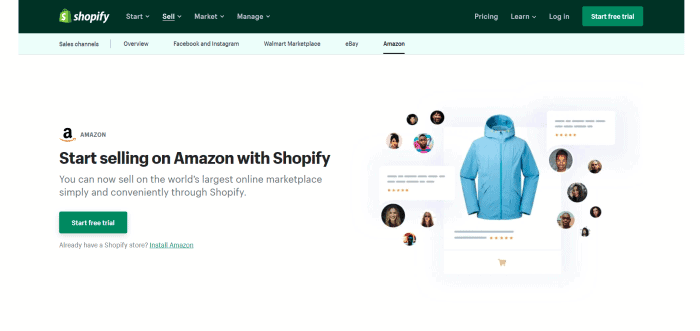
With this option, your products will be hosted in Shopify, but you can create Amazon product listings for selling them on Amazon.
This can be a win-win solution, because instead of having to decide whether to sell on Shopify or Amazon, why not sell on both?
Winner: Shopify, because it allows for greater ownership of your sales channels—where one of which can be Amazon.
Round 7: Shipping Cost Settings of Shopify ecommerce vs Amazon
Apart from fulfilling your orders yourself, you may find Amazon’s FBA feature handy if you’ll be selling on Amazon.
Using FBA, Amazon will help pack and ship your products to customers on your behalf. This can be a major load off your shoulders, because Amazon takes care of the entire fulfillment process for you.
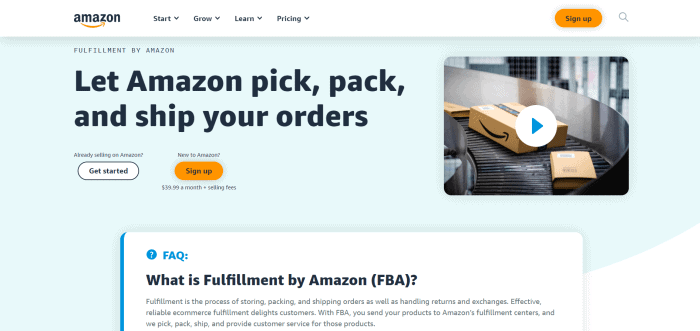
But before signing up for FBA, take the time to understand how it works, including the various fees.
For example, you’ll need to ship your products to Amazon’s fulfillment centers so that Amazon can dispatch these to customers when you get orders.
Amazon fees vs Shopify
Amazon then charges fees for storing your products, fulfilling your orders and processing returns.
Heck, Amazon also charges fees for just helping to return or dispose of your stuff for you.
Similarly, Shopify has a fulfillment network that can help you fulfill your orders. However, the pricing isn’t so transparent—you’ll need to contact the Shopify team to get a custom quote.
Separately, if you plan to do dropshipping (where a third-party supplier will ship products directly to your customers when an order is placed), you can look into connecting your Shopify business with the Oberlo dropshipping platform.
Winner: Amazon, because its FBA service is very established. I also wish Shopify could provide more info on its prices for helping you with fulfillment.
The benefit of putting your business online is that you can reach an international audience—and Amazon and Shopify are no different in this regard.
For example, if you set up a Shopify store, you can then sell to technically any country in the world, so long as your payment processor supports the customer’s payment mode.
Likewise for Amazon, where if you’ve listed your products on Amazon’s US platform, customers all over the world can access the Amazon US platform and buy your products.
That said, there are some differences.
Differences between Amazon and Shopify
Amazon offers a few different country-specific platforms or marketplaces, such as Amazon UK and Amazon FR, which are displayed in the countries’ native languages and currencies.
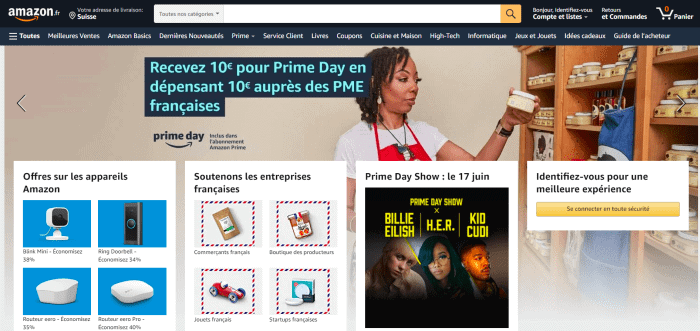
These country-specific platforms have different sign-up requirements from Amazon’s US platform, which means that you’ll need to individually apply to join these platforms even if you’re already all set up on Amazon’s US platform.
On the other hand, you can make your Shopify store multilingual and have your online site pages displayable in different languages by installing a suitable translation app.
And if you use Shopify Payments (see the discussion in Round 5), you can also sell your products in multiple currencies.
Winner: Amazon, because it makes reaching an international audience a lot easier even if you don’t speak the target market’s language very well, compared to setting up your own Shopify business.
Round 8: Support of Shopify ecommerce vs Amazon
Shopify and Amazon both provide an extensive knowledgebase of articles that you can rely on if you need help getting your business up and running. But if you’d prefer to talk to a human, you can submit a support ticket.
And this is where the platforms and marketplaces greatly diverge in terms of support quality.
Our 24/7 live support test
Our tests of Shopify’s 24/7 live support produced stellar results. Its support staff was able to provide great answers to most of our questions, even the sneakier ones.
As for Amazon’s live support, I’d say not to have too high expectations.
That’s because the general consensus among Amazon sellers seems to be that Amazon’s live support can be slow (or even non-existent), and unable to resolve the seller’s issue.
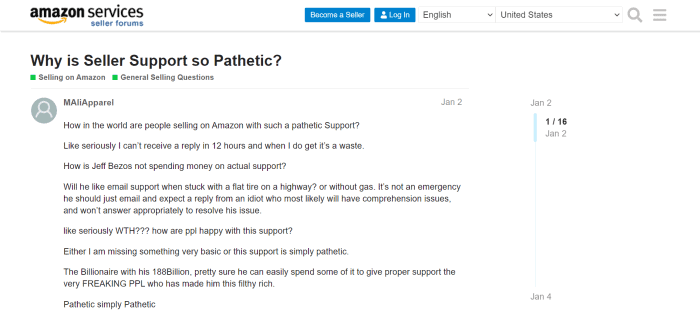
If you have a question with your own Amazon online store, it seems that you’re better off asking other sellers for help in Amazon’s Seller Central forum, or trying to find an answer in the knowledgebase yourself.
Winner: Shopify, thanks to its superior support experience.
Round 9: Fees and costs of Shopify ecommerce vs Amazon
Shopify’s fees are relatively straightforward. You’ll pay a monthly fee of between $29 and $299 for your Shopify plan and beyond that, you’ll pay transaction fees for every successful sale.
Depending on whether you have Shopify Payments enabled (see the discussion in Round 5), these transaction fees can range from 2.4% + $0.30 to 4.9% + $0.30 of each sale.
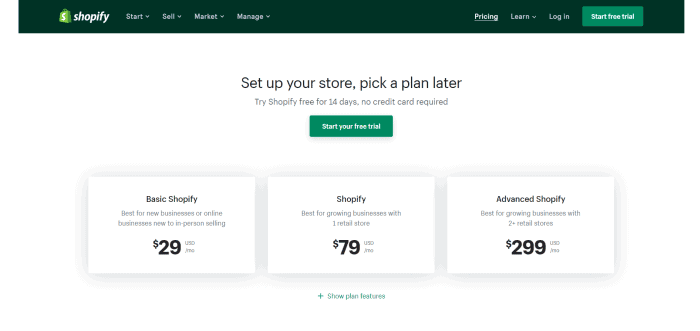
In contrast, Amazon’s fees can be more complicated.
How to start selling on Amazon?
To start selling on Amazon, you’ll first need to opt between these two plans:
- The Individual plan, where you’ll pay $0.99 per unit sold
- The Professional plan, which is a flat $39.99 per month, regardless of the number of sales you make in a month
While Amazon will absorb the transaction fee for every successful sale, it’ll take a big cut to cover it (and more).
The exact referral fee depends on the product category, and starts at 8% but can go as high as 45% of the total price (which includes shipping fees).
Apart from these, there are also fulfillment fees to consider especially if you’ll be using FBA.
Shopify doesn’t charge fulfillment fees because you have to fulfill orders yourself, so don’t forget to factor in the costs for these when comparing your outlay for using each platform.
Winner: Shopify, for having a simpler pricing structure.
Amazon’s overwhelming popularity
Amazon’s overwhelming popularity among shoppers means that sellers may be able to get customers with less marketing efforts—unlike how a Shopify seller would need to invest more in marketing to direct traffic to their online website.
As a whole, I suggest that Amazon is a good platform for sellers with more experience in ecommerce, or who are confident in their ability to navigate Amazon’s various fulfillment options and compliance policies.
With Amazon, you can leverage its wide customer base to grow your earnings, especially if you’re not too fussed with your branding for the time being.
Shopify features…
On the other hand, if you intend to build not just a store, but also your own brand, then Shopify is the better bet.
Thanks to a wide range of customization options, you can create a ecommerce website that truly reflects your brand.
You will also have full ownership of your sales channels, which is instrumental for building an ecommerce empire in the long run.
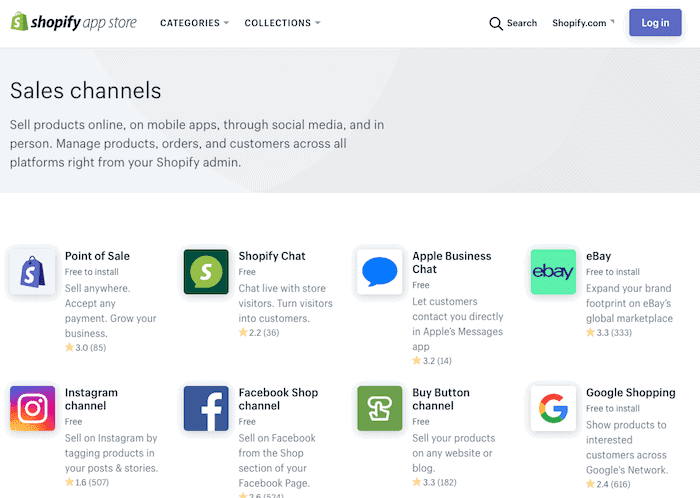
Are Shopify stores beginner-friendly?
Shopify is also the more beginner-friendly option, presenting a gentler learning curve for new ecommerce sellers to familiarize themselves with the ins and outs of running an online store.
Then, once you’ve become more seasoned in selling online, you can look at expanding your sales channels—including venturing to the Amazon platform, and running online websites on both Shopify and Amazon to get the best of both worlds.
Shopify’s Amazon app helps to make this process pretty straightforward.
Shopify vs Amazon : our conclusion
We hope that you’ve found this guide on Shopify vs Amazon useful! You can read our detailed review of Shopify to learn more about the platform, or sign up for a free Shopify trial if you’re keen to try it out for yourself.
If you don’t fancy Amazon, but you’re still not sure about Shopify, check out our BigCommerce review, as it’s the most natural alternative to Shopify (also Shopify vs BigCommerce).
We’re also happy to address any questions you may have in the comments.
THE BEHIND THE SCENES OF THIS BLOG
This article has been written and researched following a precise methodology.
Our methodology